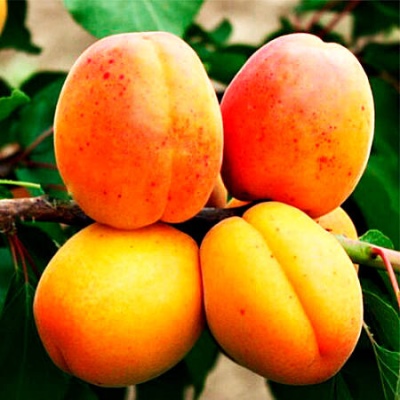
- Authors: Nikitsky Botanical Garden (Crimea)
- Fruit weight, g: 80
- Fruit shape: oval, with a rounded top
- Skin : slightly pubescent
- Fruit color: light orange, most of the fruit has a carmine blush
- Pulp color : Orange
- Pulp (consistency): juicy, tender
- Fruit taste: sweet, harmonious
- Bone size: small
- Separability of the bone from the pulp: good
Apricot Masterpiece is a magnificent example of the work of Crimean breeders, bred in the Nikitsky Botanical Garden and invariably appears in the ranking of the most delicious varieties of this southern fruit. Taste qualities are not the only advantage of this apricot, and you can guess this from the name. Large-fruited, frost-resistant, withstands low critical temperatures, calmly endure transportation, very beautiful, attractive appearance, it enjoys well-deserved recognition from gardeners.
Breeding history
The selection of the Nikitsky Botanical Garden is a rather high recommendation for the characteristics of the variety. Gardeners know other excellent examples of the work of botanical scientists. Some of them have been in demand for many centuries, although they belong to old collections. The Crimean peninsula is a fertile climate and generous land, this time they represent a sample that can be grown not only in the south. This is a variety with a stable immunity, capable of resisting unfavorable weather conditions in central Russia, the Central Black Earth Region and the Moscow Region.
Description of the variety
A medium-sized tree with a rounded, raised crown, characterized by stable fruiting and high productivity. Undeniable arguments in favor of purchasing it:
the variety is self-fertile, gives an average of 35 kg per tree;
fruits of an attractive appearance, dominant color, browned to a red-orange color in places of permanent sun exposure;
the taste is unique, sweet, has a strong aroma;
additional bonuses - fruiting in the second year, average ripening periods and resistance to winter cold with severe night frosts.
The demand for this variety on the market is understandable - its fruits are to the taste of even the most picky gourmets. It is a dessert rather than a universal look, but it can be used for winter preparations to support immunity with vitamins and minerals during a long cold period.
Fruit characteristics
With good care, apricots reach 80 g or more, abundantly covering the tree from the second or third year of cultivation. Fruits grow not only on spurs and bouquet twigs, but also on last year's growths. Therefore, careful pruning is recommended. The stone takes up little space and separates well from the soft creamy juicy pulp, which opens when you break the orange-red fruit with a slightly velvety skin.
The abundance of sweet juice in it makes it possible to prepare jams, preserves, fruits in their own juice, compotes. But the most attractive is the use of ripe fruits fresh.
Taste qualities
The pulp is tender and sweet, melts in the mouth. No hint of bitterness or sourness. Exotic notes of pineapple and peach are found in the aftertaste. But these are subjective sensations. The masterpiece smells and is felt on the tongue, as befits an apricot of that name. Studies have shown a rich set of trace elements and vitamins that are preserved even during heat treatment. The bone pulp is also sweet and can be used in culinary delights.
Ripening and fruiting
Apricot Masterpiece is classified as a medium-ripening variety - the harvest begins in the second half of July. In a cold summer, it can move by 1-2 weeks or be determined by the specifics of the region.It is necessary to remove fruits from a medium-sized tree on time, but this is not difficult - they are easily separated from the stalk.

Yield
Stable, fruiting annually, in especially favorable seasons, the branches must be propped up to avoid breaking. The average amount of harvest per tree is 35 kg, but this figure is increased by the care and planting of pollinators nearby. The variety can be safely recommended for commercial profit.
Growing and care
Standard conditions for choosing a landing site are south, sheltered from the wind, light shading in the middle of the day. Post-plant pruning and regular watering of the young tree are necessary. The water should reach the deep ends of the root system and not be limited to the topsoil. In the first month, you need to water in a bucket twice a week, then the intensity of watering can be reduced. Pruning and watering is a great opportunity to increase the survival rate of a seedling purchased from a proven nursery.
You won't have to make any special efforts: as with other apricots. Three times a day feeding will be required per season - during flowering, the formation of the ovary and after fruiting, mulching for the winter, shallow loosening after natural precipitation, spraying against diseases and detected pests. Each maintenance activity is gratefully received by the tree and increases the likelihood of a bountiful harvest.



































































